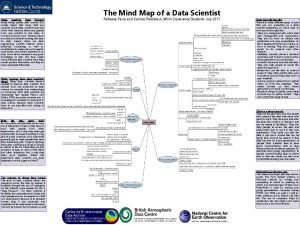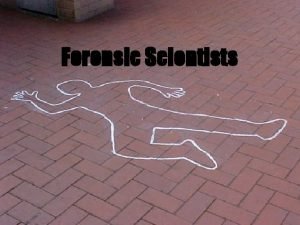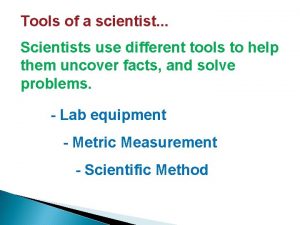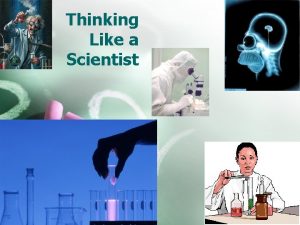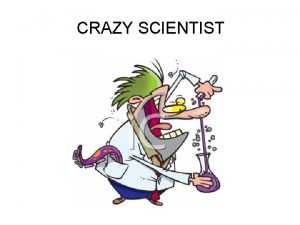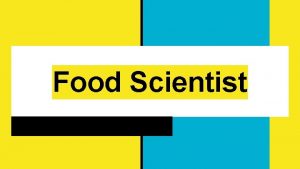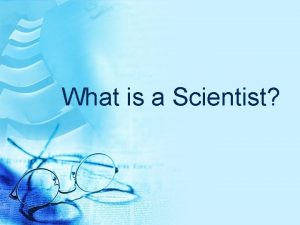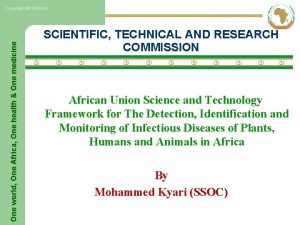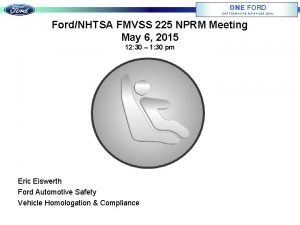Tools of the Scientist One of the most

































- Slides: 33

Tools of the Scientist

• One of the most important tools is the compound microscope. • Used to see the microscopic world or objects too small for the naked eye. • Plant cells, animal cells and bacteria cells can be observed. • Used to diagnose cancer

The compound light microscope • The compound microscope has two sets of lenses, • Each magnifies the what you are looking at

• light to pass through a specimen on the stage to form an image. • It can make objects 1000 times its normal size. light

• The microscope must have two characteristics to be useful: 1. Magnification 2. Resolution

• Magnification: the enlarging of the image so it can be seen easier

How to determine magnification: • Multiply the eye piece by the objective. • For example if the eye piece is 10 X and the objective is 25 X, your total magnification is 250 X. • 10 x 25 =250 x 10 x 25 x

• What is the total magnification of the following microscopes? Ocular: 10 x Ocular: 15 x objective: 40 x objective: 100 x

2. Resolution is the ability to distinguish between two points. • Similar to digital cameras (mega pixels) or LED Televisions. • Good resolution makes images clearer to view. Good resolution Poor resolution

Parts of the microscope. 1. Ocular lens/eye piece: • Contains a magnifying lens, usually 10 x or 15 x.

2. Objective lens: • has three different magnifying lenses: A. Scanning lens: • magnifies image 4 X B. Low power: • magnifies 10 X C. High power: • magnifies 40 x

3. light source 4. diaphragm: regulates amount of light that passes up towards the eye piece.

5. Base: support microscope 6. Arm: supports body tube

7. Stage: supports slide to be observed. 8. Stage clips: Holds slide down on stage

9. Nosepiece: hold objectives, can be rotated. 10. Course Adjustment: moves body tube in order to focus the image.

11. Fine Adjustment: moves body tube slightly to sharpen image. 12. Body tube: keeps proper distance between eye piece and objectives.


• Images viewed under the light microscope are upside down and backwards • This is a compound F light microscope view of the letter F placed on a slide in its normal position. F

Other types of microscopes 1. Transmission electron microscope: • shines a beam of electrons through a thin specimen • Works like a compound light microscope but higher magnification.

mitochondria

2. Scanning Electron Microscope: • produces a 3 D image. • Runs a beam of electrons back and forth across the surface of the specimen. • Magnification of 500, 000 x

Image under scanning electron microscope

Sperm on egg

Red Blood Cell

1. Red blood cells under a compound light microscope 2. Red blood cell in a capillary under a transmission electron microscope 3. Red blood cells under a scanning electron microscope

Other important lab techniques 1. Chromatography 2. Gel electrophoresis

1. • Chromatography A lab technique used to separate mixtures. • Often done on paper • The chemicals separate based on density. • The solvent is absorbed up the paper, • separating the mixtures place on the paper by the scientist. Animation: http: //www 3. wooster. edu/chemis try/analytical/gc/default. html Solvent moves up paper

• How paper chromatography works. • Watch the water move up as it is absorbed by the paper. • Separates the chemicals that make up the black dot as it moves.


2. Electrophoresis • used to separate molecules such as DNA by size and charge • charged molecules like DNA are placed in an electric field, they migrate toward either the positive or negative pole according to their charge.

• Put DNA in the wells, • Plug it in • Separates based on size of molecules and charge • DNA has a negative charge, so its attracted to the positive side. • Smaller pieces move further • Every ones DNA is unique • Everyone's DNA separates in a unique pattern.

• Gel electrophoresis is one way to determine your baby’s momma • Also used to solve crimes Animation: http: //fotofox 17. deviantart. com/art/Gel-Electrophoresis-Animation-87035741

Electrophoresis pics The set up
 Scientist tools
Scientist tools Scientist tools
Scientist tools Who was the most famous scientist of the hellenistic era
Who was the most famous scientist of the hellenistic era One god one empire one emperor
One god one empire one emperor One one one little dogs run
One one one little dogs run One king one law one faith
One king one law one faith One god one empire one emperor
One god one empire one emperor One team one plan one goal
One team one plan one goal See one do one teach one
See one do one teach one One price policy
One price policy Twelfth night speeches
Twelfth night speeches Studiendekanat uni bonn
Studiendekanat uni bonn One vision one identity one community
One vision one identity one community Graphic organizer with the aims of la liga filipina
Graphic organizer with the aims of la liga filipina The appropriate cutting tool used in cutting fabrics
The appropriate cutting tool used in cutting fabrics Food scientists measure food energy in
Food scientists measure food energy in Data scientist ausbildung wien
Data scientist ausbildung wien Things a computer scientist rarely talks about
Things a computer scientist rarely talks about The diagram below shows how a coverslip should be lowered
The diagram below shows how a coverslip should be lowered Making of a scientist mind map
Making of a scientist mind map Far side rocket scientist
Far side rocket scientist Staff scientist nih
Staff scientist nih Si derived unit of pressure scientist
Si derived unit of pressure scientist The strange sea monster of strawberry lake
The strange sea monster of strawberry lake Penjual sebagai artis dan scientist
Penjual sebagai artis dan scientist What does forensic mean in latin
What does forensic mean in latin What makes a scientist
What makes a scientist Chartered scientist
Chartered scientist Mark hughes founder of herbalife
Mark hughes founder of herbalife Burned fire scientist questions arson
Burned fire scientist questions arson Avogadro scientist
Avogadro scientist Certificated natural scientist
Certificated natural scientist Chief scientist office scotland
Chief scientist office scotland World bank data scientist
World bank data scientist



















